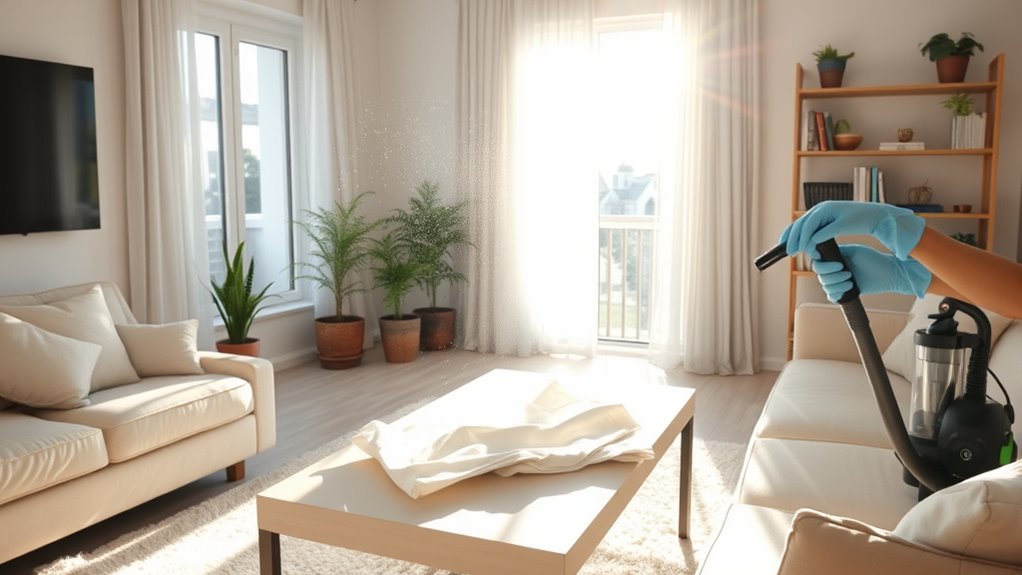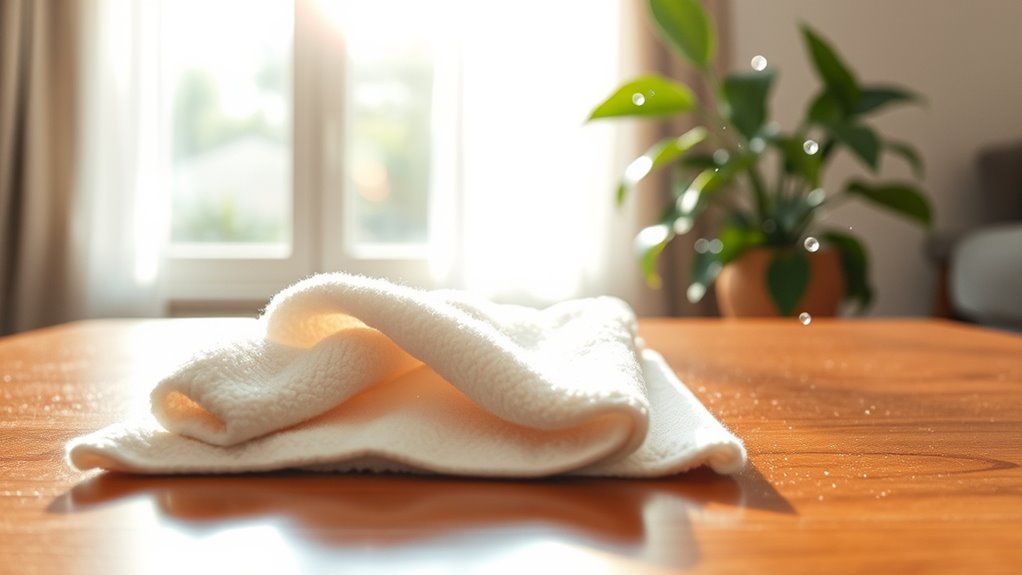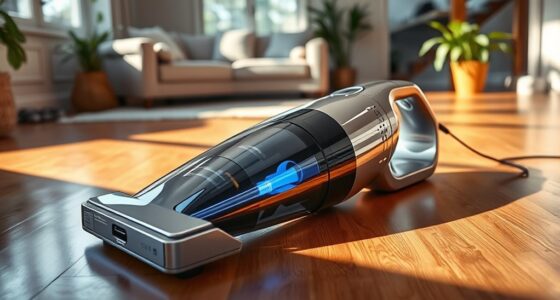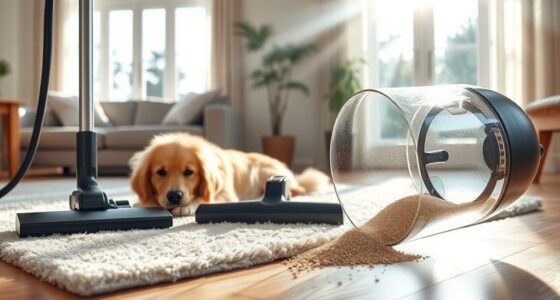To reduce household dust, start by using a vacuum cleaner with a HEPA filter and vacuum at least once a week, focusing on hidden areas. Dust surfaces with a damp microfiber cloth to capture particles effectively, and declutter to minimize dust hotspots. Change your bedding weekly and clean curtains regularly to combat allergens. Keep windows closed on windy days, and be strategic when letting fresh air in. There’s more to discover about maintaining a dust-free home environment.
Key Takeaways
- Invest in a HEPA-filtered air purifier to effectively reduce airborne dust and allergens in your home.
- Vacuum weekly with a HEPA-filtered vacuum to trap fine particles and prevent dust accumulation.
- Use a damp microfiber cloth for dusting to capture dust without spreading it into the air.
- Wash bedding weekly and clean curtains regularly to minimize dust and allergens from fabrics.
- Keep windows closed on windy days to limit outdoor dust entry, and open them when pollen counts are low.

How can you create a cleaner, healthier home? Reducing household dust is one of the most effective ways to achieve that goal. Dust not only makes your living space look dirty but can also trigger allergies and respiratory issues. By adopting mindful cleaning practices, you can considerably cut down on the dust in your home.
Start by investing in an air purifier. The air purifier benefits include filtering out dust, pollen, and other allergens, improving your indoor air quality. When you run it regularly, especially in high-traffic areas or rooms where you spend a lot of time, you’ll notice a difference in how you feel. It’s a great way to breathe easier, especially if you’ve got allergies. Just make sure to choose a model with a HEPA filter for maximum effectiveness.
Investing in an air purifier with a HEPA filter significantly improves indoor air quality, helping you breathe easier and reducing allergens.
Regular vacuuming is another vital step. When you vacuum, aim for a vacuum cleaner equipped with a HEPA filter too. It’ll trap fine particles that standard vacuums might just spread around. Make it a habit to vacuum at least once a week, and don’t forget about those less obvious spots like under the furniture and behind appliances.
Dusting surfaces is essential, but how you do it matters. Use a damp microfiber cloth instead of a dry one, which can just stir dust into the air. This technique helps capture the dust, preventing it from floating around the room. While you’re at it, think about decluttering your space. The more knick-knacks and unnecessary items you have, the more surfaces there are for dust to settle.
Don’t overlook your bedding and curtains, either. Wash your sheets weekly and curtains every couple of months. These fabrics can trap considerable amounts of dust and allergens. If you’re sensitive to dust, consider using hypoallergenic bedding that resists dust mites.
Finally, remember to keep your windows closed on windy days. Outdoor dust and pollen can easily find their way inside, especially if you have open windows. If you need fresh air, try to do so when the pollen counts are low, or consider using your air purifier to mitigate any incoming allergens. Additionally, color accuracy in your home cinema projector setup can enhance your viewing experience without adding to the dust accumulation in your space.
Frequently Asked Questions
What Tools Are Most Effective for Dusting Surfaces?
For effective dusting, you’ll find that electrostatic cloths and microfiber tools are your best bets. Electrostatic cloths attract dust like a magnet, making them perfect for quick clean-ups. Microfiber tools, on the other hand, capture dust particles without spreading them around. Use them on various surfaces, and you’ll notice a significant reduction in dust buildup. Incorporating these tools into your cleaning routine helps keep your home looking and feeling fresh.
How Often Should I Clean to Minimize Dust?
To keep dust from piling up like autumn leaves, you should clean at least once a week. This cleaning frequency helps you stay ahead of dust accumulation, ensuring your home feels fresh and inviting. Don’t forget to tackle hidden spots, like under furniture and behind appliances, where dust loves to hide. By committing to a regular cleaning routine, you’ll create a healthier environment and breathe easier in your space.
Can Air Purifiers Help Reduce Household Dust?
Yes, air purifiers can substantially help reduce household dust. Their efficiency lies in filtering out fine particles, including dust and allergens, from the air. When you use an air purifier, you’re actively lowering the allergen levels in your home, creating a healthier environment. Just make sure to choose a model with a HEPA filter for peak performance. Regular maintenance and filter changes will keep it running effectively, ensuring you breathe easier.
Are Certain Materials More Prone to Collecting Dust?
Yes, certain materials are definitely more prone to collecting dust. For example, imagine you’ve got a cozy, velvet couch. That plush fabric acts like a dust magnet, attracting allergens and particles. In contrast, smoother materials like leather or synthetic fabrics tend to resist dust accumulation. To keep your home cleaner, you might want to avoid fabric choices that are allergen prone, opting instead for easier-to-clean options that repel dust more effectively.
What Role Does Humidity Play in Dust Accumulation?
Humidity plays a vital role in dust accumulation. High humidity levels can create a breeding ground for dust mites, which thrive in moist environments. By controlling humidity, you can considerably reduce dust mite populations and their contributions to household dust. Aim to keep indoor humidity between 30% and 50% to minimize dust buildup. Using dehumidifiers or air conditioners can help you achieve this balance, making your home cleaner and more comfortable.
Conclusion
So, as you diligently clean every nook and cranny to reduce dust, remember that your efforts might just stir up more dust in the process. It’s a bit ironic, isn’t it? You’re battling the very particles that seem to multiply with every swipe of the cloth. But don’t let that discourage you. Embrace the cycle of cleaning and dusting—it’s a reminder that even in our attempts to control chaos, life has its own way of reminding us to keep trying.









